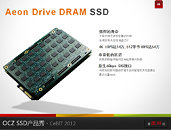- Joined
- Oct 9, 2007
- Messages
- 47,480 (7.49/day)
- Location
- Hyderabad, India
| System Name | RBMK-1000 |
|---|---|
| Processor | AMD Ryzen 7 5700G |
| Motherboard | ASUS ROG Strix B450-E Gaming |
| Cooling | DeepCool Gammax L240 V2 |
| Memory | 2x 8GB G.Skill Sniper X |
| Video Card(s) | Palit GeForce RTX 2080 SUPER GameRock |
| Storage | Western Digital Black NVMe 512GB |
| Display(s) | BenQ 1440p 60 Hz 27-inch |
| Case | Corsair Carbide 100R |
| Audio Device(s) | ASUS SupremeFX S1220A |
| Power Supply | Cooler Master MWE Gold 650W |
| Mouse | ASUS ROG Strix Impact |
| Keyboard | Gamdias Hermes E2 |
| Software | Windows 11 Pro |
As a leading SSD vendor, OCZ sure has a strong engineering muscle to flex. Flex it did, with the AEONDrive DRAM SSD. This drive uses DRAM as its primary storage medium (as long as there's a constant power source). The device is thus ideal for those parts of the datacenter which hold "hot data". Unlike similar solutions such as FusionIO drives, the AEONDrive utilizes SAS 6 Gb/s interface. SAS is a low-overhead protocol since it allows exchange of larger numbers of simultaneous host commands than ATA. As for the performance OCZ claims the AEONDrive provides 140,000 IOPS 4K, and 540,000 IOPS 512. Since DRAM is a much lower-density medium than NAND flash, one should expect AEONDrives to be available only in relatively low capacities such as 64 GB (still big enough for pain databases). Not much more is detailed about the drive. It would be great if the AEONDrive could back itself up onto NAND flash before turning itself off.

View at TechPowerUp Main Site

View at TechPowerUp Main Site
Last edited:







